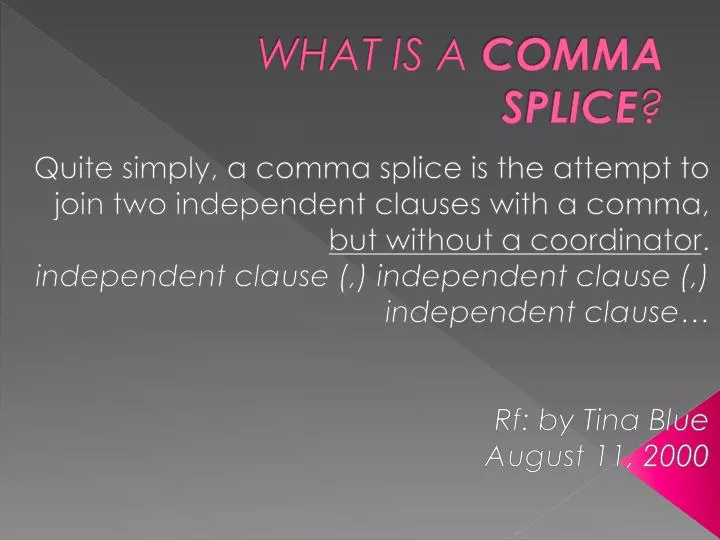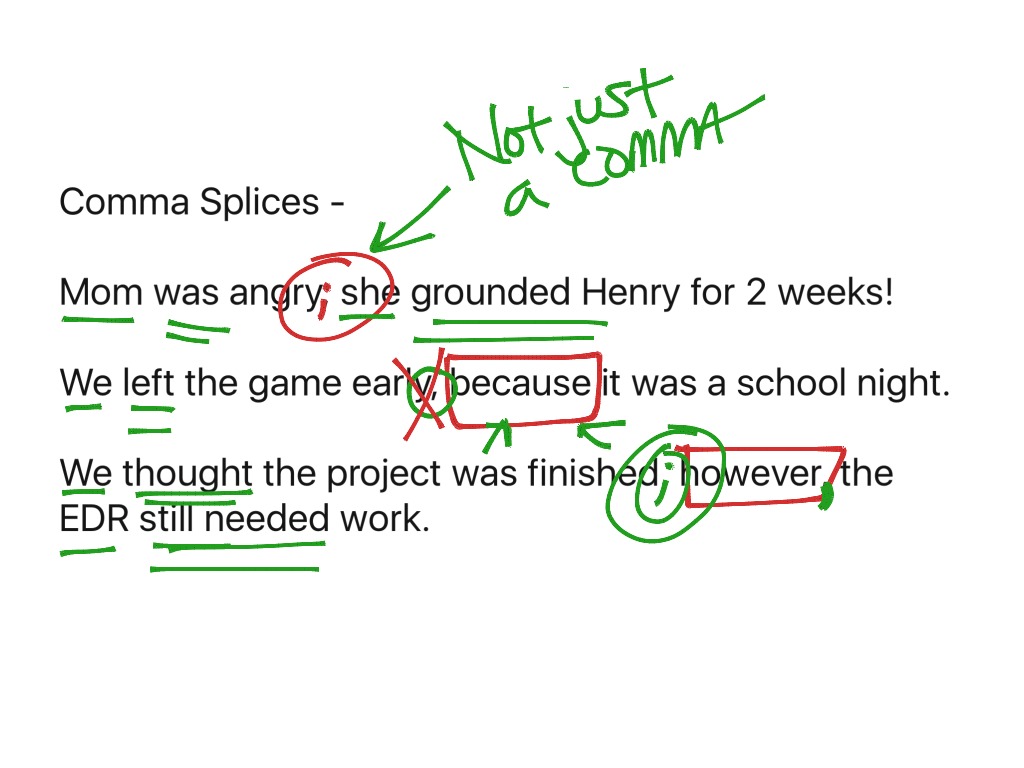

To demonstrate a particular relationship between clauses, or generate a particular flow, you could replace the comma with an appropriate conjunction: Most simply, we could separate the clauses into separate sentences: She went into the basement, the lights weren’t working.If you find they’re not, this is fairly simple to fix.

Once you’ve got the hang of identifying independent clauses, to avoid comma splices ask yourself if your clauses are appropriately connected. It’s very much a case of only bending the rules when you have mastered them, and even then only if you can confidently justify why you’re doing it – and note that it is only justifiable in very specific circumstances, which will often fall into the realm of deliberate mistakes anyway.
A COMMA SPLICE EXAMPLE FULL
I read an Elmore Leonard book ( Maximum Bob I believe) which was full of comma splices, for example, but Elmore Leonard was an exceptional writer with a very specific style (in this case often reflecting a character of a certain low class’s mode of language). That said, it’s a technique that few writers can get away with. In this example, it’s actually working similarly to an adverbial, but it gives it a particular twist: “hating the dark” would be the expected, grammatically correct form, but “hated the dark” sets the verb differently, as a rule, or a complete, emphatic action. She muttered under her breath, hated the dark.She muttered under her breath – hated the dark.She muttered under her breath hated the dark.It can create a slightly different feel when we have a shared subject with a follow-on action that adds a response or feeling. It’s less formal than using a semi-colon and more subtle than using a dash, both of which would be the more accepted styles. This is most often the case where a writer wants to add information running directly on without distinct connectors. It’s an easy mistake to make, and an easy one to miss. She went into the basement because the lights weren’t working.īut if you read enough in English, particularly in fiction, you’re almost guaranteed to come across some comma splices eventually.She went into the basement where the lights weren’t working.Without more context, for example, we could easily express different scenarios depending on the chosen connector: She went into the basement, the lights weren’t working, it was very dark.īy using a comma, we’d also miss the opportunity to demonstrate how separate ideas are connected.It can also make it more difficult to read as we won’t pause in the right places, creating a clumsy flow where information isn’t clearly separated: How problematic this is depends on the sentence the examples above aren’t confusing, but longer sentences or ones with different subjects could be. It can actively affect the way a sentence is read. Well, the simplest explanation is that commas are not intended to be used in this way and it’s therefore likely to cause confusion with readers. You might read them and think they make sense, though, so why does it matter? When compared to sentences that use semi-colons to bridge clauses, it might look like there’s little difference, after all. In the examples above, the comma splices are technically incorrect. The second example here, with the dash, creates a sentence fragment, which can be more acceptably linked by a dash than a comma (though depending on the context even the dash might not be welcome as always, the more formal a text, the more likely it would be to stick to expected rules and conventions). She went into the basement, tried to turn on the lights.She went into the basement – tried to turn on the lights.She went into the basement and tried to turn on the light.However, even if the verbs share a subject, which does not necessarily need to be repeated, a new active verb can still form a separate independent clause that needs connecting: In the example above, the verbs “went” and “weren’t” indicate distinct clauses, made clearer because we have separate subjects “she” and “the lights”. subordinating conjunctions like when, as, or relative pronouns like who, which). To break this down a little more, and help identify such splices, remember that an independent clause occurs whenever we have a new verb and subject, without any connectors that link it dependently to another clause (e.g. She went into the basement the lights weren’t working.She went into the basement but the lights weren’t working.Simply put, a comma splice is when you have a comma combining independent clauses, where you would otherwise expect to see a conjunction or conjunctive punctuation (for example a semi-colon, colon or dash), or two separate sentences.


 0 kommentar(er)
0 kommentar(er)
